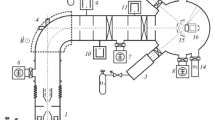Abstract
The preliminary irradiation of a tungsten sample with low-energy helium ions (80 eV, flux of 1021 m−2 s−1) at a temperature of 1200–1250 K in a facility with an inductive RF discharge leads to the formation of a nanostructured tungsten surface layer, which is referred to as fuzz. After that, the sample is subjected to a set of annealing procedures and irradiations with \({\text{D}}_{3}^{ + }\) ions with an energy of 2 keV (0.67 keV per D) at low fluences of 1019–1020 m−2. Deuterium retention at each stage is analyzed by in-situ thermal desorption spectroscopy. An increase in the helium concentration in the sample leads to a significant change of deuterium retention. At high helium concentrations, deuterium retention becomes low. Annealing in the temperature range of 1000–1400 K leads to helium desorption, modification of the surface layer and defects, and, as a consequence, an increase in the amplitude of the main deuterium desorption peak and a shift of the peak to higher temperatures. Annealing at a temperature of 1600 K leads to removal of the nanostructured fuzz from the tungsten surface and a decrease in the deuterium retention on account of an increase in the reflection coefficient from a smoother surface.





Similar content being viewed by others
REFERENCES
R. A. Pitts, X. Bonnin, F. Escourbiac, et al., Nucl. Mater. En. 20, 100696 (2019). https://doi.org/10.1016/j.nme.2019.100696
C. Bachmann, F. Arbeiter, L. V. Boccaccini, et al., Fusion Eng. Des.112, 527 (2016). https://doi.org/10.1016/j.fusengdes.2016.05.040
Z. R. Harutyunyan, Yu. M. Gasparyan, V. S. Efimov, et al., Bull. Russ. Acad. Sci.: Phys. 84, 727 (2020). https://doi.org/10.3103/S1062873820060040
O. V. Ogorodnikova, T. Schwarz-Selinger, K. Sugiyama, and V. Kh. Alimov, J. Appl. Phys. 109 013309 (2011). https://doi.org/10.1063/1.3505754
V. Kh. Alimov, W. M. Shu, J. Roth, et al., Phys. Scr. 138, 014048 (2009). https://doi.org/10.1088/0031-8949/2009/T138/014048
G. De Temmerman, T. Hirai, and R. A. Pitts, Plasma Phys. Controlled Nucl. Fusion Res. 60, 044018 (2018). https://doi.org/10.1088/1361-6587/aaaf62
S. Takamura, N. Ohno, D. Nishijima, and S. Kajita, Plasma Fusion Res. 1, 051 (2006). https://doi.org/10.1585/pfr.1.051
S. Kajita, W. Sakaguchi, N. Ohno, et al., Nucl. Fusion 49, 095005 (2009). https://doi.org/10.1088/0029-5515/49/9/095005
K. Wang, R. P. Doerner, M. J. Baldwin, et al., Sci. Rep. 7, 1 (2017). https://doi.org/10.1038/srep42315
C. M. Parish, K. Wang, R. P. Doerner, and M. J. Baldwin, Scr. Mater. 127, 132 (2017). https://doi.org/10.1016/j.scriptamat.2016.09.018
O. V. Ogorodnikova, K. S. Klimov, A. G. Poskakalov, et al., J. Nucl. Mater. 515, 150 (2019). https://doi.org/10.1016/j.jnucmat.2018.12.023
A. Rusinov, Y. Gasparyan, N. Trifonov, et al., J. Nucl. Mater. 41, 645 (2011). https://doi.org/10.1016/j.jnucmat.2010.10.069
M. Zibrov, S. Ryabtsev, Y. Gasparyan, and A. Pisarev, J. Nucl. Mater. 477, 292 (2016). https://doi.org/10.1016/j.jnucmat.2016.04.052
S. Davies, J. A. Rees, and D. L. Seymour, Vacuum 101, 416 (2014). https://doi.org/10.1016/j.vacuum.2013.06.004
Y. Gasparyan, S. Ryabtsev, V. Efimov, et al., Phys. Scr. 171, 014017 (2020). https://doi.org/10.1088/1402-4896/ab4068
M. Yajima, N. Yoshida, S. Kajita, et al., J. Nucl. Mater. 449, 9 (2014). https://doi.org/10.1016/j.jnucmat.2014.02.027
S. Ryabtsev, Y. Gasparyan, M. Zibrov, et al., Nucl. Instrum. Methods Phys. Res., Sect. B 382, 101 (2016). https://doi.org/10.1016/j.nimb.2016.04.038
K. Doi, H. T. Lee, N. Tanaka, et al., Fusion Eng. Des. 136, 100 (2018). https://doi.org/10.1016/j.fusengdes.2018.01.001
Funding
Microscopic studies of the sample surface were conducted at the Center for collective use “Heterostructure Microwave Electronics and Wide-Gap Semiconductor Physics” under the support of the Ministry of Science and Higher Education of the Russian Federation (project no. 0723-2020-0043). This work was supported by the Russian Science Foundation (project no. 17-72-20191).
Author information
Authors and Affiliations
Corresponding author
Additional information
Translated by M. Timoshinina
Rights and permissions
About this article
Cite this article
Harutyunyan, Z.R., Ogorodnikova, O.V., Aksenova, A.S. et al. Deuterium Retention in a Nanostructured Tungsten Surface Layer Formed during High-Temperature Irradiation with Helium Plasma. J. Surf. Investig. 14, 1248–1253 (2020). https://doi.org/10.1134/S1027451020060245
Received:
Revised:
Accepted:
Published:
Issue Date:
DOI: https://doi.org/10.1134/S1027451020060245



